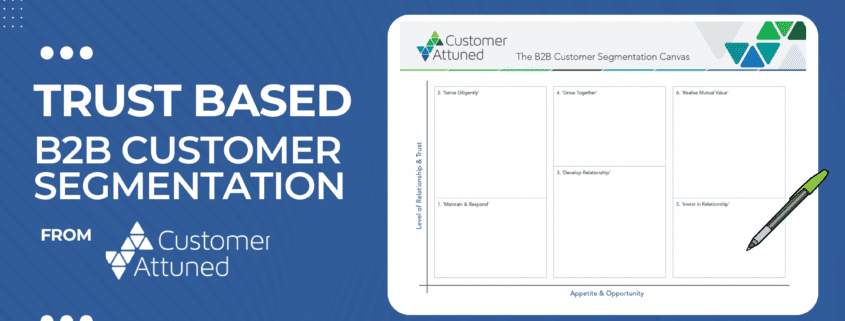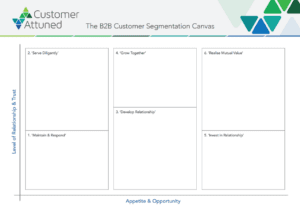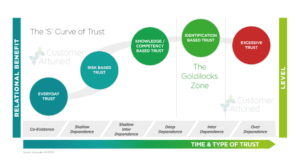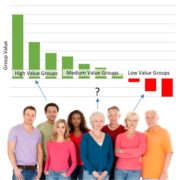Trust-Based Customer Segmentation
Our purpose at Customer Attuned is “to [help clients] build a culture of Customer Centricity based on B2B Trust so that sustainable, mutually beneficial and profitable relationships are developed and maintained”. As you may already know, we have developed and published a new Customer Segmentation framework called The Customer Segmentation Canvas. In this post, Associate Director Paul Cranston brings together the concepts of trust and segmentation, and considers the value of trust-based customer segmentation.
Introduction to 2 Key Principles
The Customer Segmentation Canvas
The Customer Segmentation Canvas has been developed to complement Strategyzer’s ‘Business Model Canvas’. This powerful tool considers key start-up challenges, helping to re/define businesses. On the right of the Business Model Canvas is “Customer Segments” – an area for exploration that we believe benefits from embellishment! Hence, we took our own customer segmentation model and re-purposed it as The Customer Segmentation Canvas. The resulting segmentation framework guides an organisation’s approach to customer management.
B2B Trust
Customer Attuned co-founder Dr Mark Hollyoake, researched and published a definition of B2B trust. He says “B2B Trust is the willingness to be vulnerable to another party and the decision to engage in actions based upon an interpretation of their ability, credibility and the expectations of mutual value exchange over time.” Trust, as illustrated on the S-Curve of Trust, below, is dynamic and has movement forwards and, crucially, backwards. Organisations need to build trust one level at a time with each customer. There are likely to be many organisations at different stages of trust. This is where effective Customer Segmentation can really help.
Trust-Based Customer Segmentation
In creating the Customer Segmentation Canvas, we wanted to affirm the importance of Trust. So, the vertical axis of the canvas represents the levels of trust as set out within the S-Curve of Trust. The greater the trust, the higher up the axis a customer is positioned.
A key difference between the canvas and traditional approaches to segmentation (such as industry, sector, turnover, etc) is that it recognises both the level of trust, and the appetite and opportunity for a deeper relationship. We believe that this makes the Customer Segmentation Canvas the most Customer Centric approach to segmentation, putting customers’ wants and needs at the heart of your customer management.
High Trust Customers
There are customers that appreciate your business engagements, value your offering and recognise the potential that a deepened relationship can provide. These are the customers that have a high level of trust and a depth of relationship, and appetite and opportunity for more. This attitude positions them higher on the vertical axis, and further right along the horizontal axis. These customers have the potential to be your best customers!
Low Trust Customers
The canvas provides for customers that just want and need a simple transactional relationship with you and nothing more. They have no further desire or need to buy further products. And that is OK!
Recognising this attitude and behaviour in your segmentation framework means that your teams can manage them most appropriately – avoiding unwanted sales pressure that could result in negative sentiment.
Benefits of Using Trust-Based Customer Segmentation
This trust-based customer segmentation approach allows organisations to firstly recognise where customers are on their relationship journey. In other words, the canvas can be used to confirm who your existing best customers are (although you know this already!), who your next best customers might be (so where you might invest resources in to for future growth) and which customers you can leave be (and commit to keeping them content).
Secondly, the canvas helps you define the desired behaviours to either protect the existing relationship status, or develop the relationship further, which results in customer retention and / or growth.
Additionally, understanding your customers by using their own attitudes and behaviours allows you to create ideal customer profiles for marketing and sales activities. This profiling can help target customers by what you need – when your pipeline lacks future best customers, create campaigns based on your Segment 4 and 6 profiles!
Adopting Trust-Based Customer Segmentation
We have put together resources to get you started with your own Segmentation programme. Please take a look at The Customer Segmentation Canvas to begin your journey.
A question that we frequently get asked is: “how do you measure trust?”. We have two services that help with this: the Partnership Survey and the Voice of The Customer Survey.
Get in touch with our Customer Management consultants today if you would like to discuss how your company can redefine its approach to segmentation or to help with understanding the levels of trust between your organisation and your customers.
Want to chat with Paul directly about this post? Message via LinkedIn.
- AMPLIFY Account Management Training and Trust - April 14, 2025
- The Partner Relationship Survey and Trust - January 29, 2025
- The 6 Segments of Customer Segmentation - December 4, 2024








